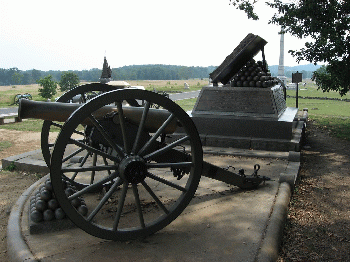
High Water Mark Monument, Gettysburg National Military Park, Pennsylvania (1)
(Image by Ken Lund from flickr) Details DMCA
Russia's goal is not to destroy Ukraine - this could be accomplished at any time. Rather, the goal of Russia is to destroy NATO by exposing its impotence.
In the quiet fields outside the sleepy college town of Gettysburg, Pennsylvania, sits a bronze monument, in the form of an open book. Known as the "High-Water Mark of the Rebellion" monument, it contains the identities of the various military formations that, in the afternoon of July 3, 1863, fought a life and death struggle on and around the soil where the monument is set.
Here, some 12,500 men under the command of Confederate Lieutenant General James Longstreet, formed into three divisions, and launched a frontal assault on some 10,000 entrenched Union troops commanded by Major General Winfield Scott Hancock.
While around 1,500 confederates managed to pierce the Union line, they were quickly surrounded and compelled to either surrender or die. It is at this point on the battlefield that the "High-Water" monument is located, commemorating what has become to be known as "Pickett's Charge," named after one of the division commanders who participated in the battle.
The Confederate Army was able to withdraw from the Gettysburg battlefield in good order to continue to fight for nearly two more years before surrendering. But it never recovered from the disaster that was Pickett's Charge. It was truly the High-Water Mark of the Rebellion.
A Messy History
Students of history might be experiencing what Yogi Berra once famously called "De'jà vu all over again" when examining the frenetic activities undertaken by the North Atlantic Treaty Organization (NATO) today, as it responds to what it alleges is a provocative Russian military buildup along the Russian-Ukrainian border.
The Trans-Atlantic alliance is a strange amalgam of political, economic, and military belief systems cloaking a mass of 30 nations who manage the day-to-day activities of their organization through a consensus-based, collective decision-making process that is as unwieldy as it is inefficient.
Originally formed as a collective of 12 nations united by the desire, as the first secretary-general of NATO, Lord Ismay, once quipped, "to keep the Russians out, the Americans in, and the Germans down", the Trans-Atlantic alliance was, first and foremost, a club comprised of nations which had two things in common - a shared belief in the primacy of democratic governance, and a desire to be protected under the umbrella of American military power.
Early on the alliance witnessed a period of expansion, as it grew to 16 nations following the admittance of Turkey, Greece, Spain, and Portugal. These 16 nations served as the foundation of NATO throughout the Cold War, united in their determination to stand up to any potential Soviet aggression targeting the territory of western Europe.
NATO was always, from a political standpoint, a mess. Strong pro-communist movements in France and Italy led to the unseemly situation where the intelligence services of an allied nation, the United States, were engaged in manipulating the domestic political affairs of two ostensible allies to keep the communists out of power.
West Germany carried out its own unilateral Ostpolitik, seeking better relations with Soviet-occupied East Germany, much to the consternation of the United States. France, offended by what it (rightly) believed to be the dominance of the United States in the military command structure of the alliance, withdrew its military from NATO command authority. And Turkey and Greece were engaged in their own regional Cold War which, in 1974, went hot over the island of Cyprus.
(Note: You can view every article as one long page if you sign up as an Advocate Member, or higher).






